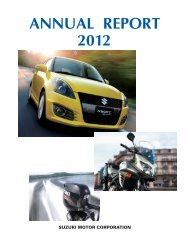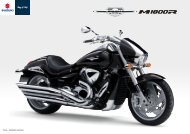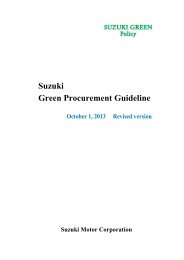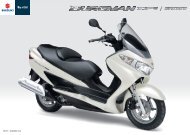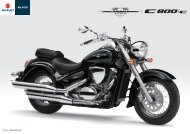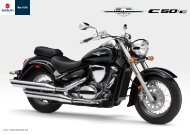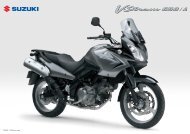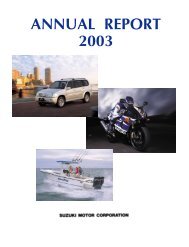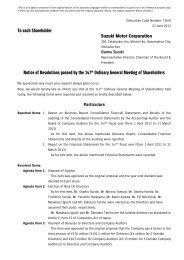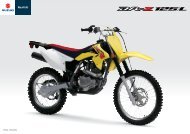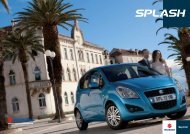2011 Suzuki CSR Report - global suzuki
2011 Suzuki CSR Report - global suzuki
2011 Suzuki CSR Report - global suzuki
You also want an ePaper? Increase the reach of your titles
YUMPU automatically turns print PDFs into web optimized ePapers that Google loves.
Introduction<br />
Special Topics<br />
Corporate<br />
Philosophy and <strong>CSR</strong><br />
Environmental<br />
Responsibility<br />
Social<br />
Responsibility<br />
Data<br />
01 Efforts for Development<br />
SUZUKI <strong>CSR</strong> REPORT <strong>2011</strong><br />
Control of Global Warming<br />
Promote CO2 emission in all areas of products, manufacturing, distribution, etc. under the<br />
policy of making parts "Smaller, Fewer, Lighter, Shorter, and Neater"<br />
<strong>Suzuki</strong> believes that reducing CO2 emission, which are connected to <strong>global</strong> warming, is important to pass on to<br />
the next generation a clean environment. Under the policy of making parts "Smaller, Fewer, Lighter, Shorter, and<br />
Neater" which is the base of wide varieties of manufacturing, <strong>Suzuki</strong> mainly provides compact cars that reduce<br />
CO2 emission. In addition, the Chairman visits each plant once a year to promote energy-saving through entire<br />
business activities and efficient manufacturing and distribution by the light and compact manufacturing line, and<br />
also to accelerate reduction of CO2 emission.<br />
01 Efforts for Development<br />
Automobiles<br />
In order to reduce CO2 emissions, which are connected to <strong>global</strong> warming, we are constantly working to develop and<br />
improve products that offer superior fuel economy.<br />
■Improvement of Fuel Efficiency<br />
1Trends in Average Fuel Efficiency by Weight Class<br />
In fiscal 2010, passenger cars in four out of five weight<br />
categories achieved the 2010 target level of fuel efficiency.<br />
(The fuel efficiency standard was achieved using credits<br />
as the whole <strong>Suzuki</strong> Group.) The fuel efficiency could be<br />
improved particularly in the light weight class (875 kg and<br />
1000 kg).<br />
Lighter vehicles tend to allow for better fuel efficiency.<br />
<strong>Suzuki</strong> contributes to improvement of fuel economy for<br />
the entire motorized society by providing lightweight<br />
automobiles (mini vehicles, compact vehicles, etc) to as<br />
many customers as possible.<br />
Average Fuel Efficiency of Gasoline Vehicles by Weight Class<br />
(Figures after fiscal 2004 exclude OEM vehicles.)<br />
27<br />
625kg<br />
2010 Fuel<br />
25<br />
Economy<br />
Standards<br />
23<br />
21.2<br />
21<br />
(less than<br />
750kg<br />
750kg)<br />
19<br />
875kg<br />
18.8<br />
17<br />
1,000kg<br />
17.9<br />
16.0<br />
15<br />
13<br />
11<br />
9<br />
7<br />
1,250kg<br />
1,500kg<br />
1,750kg<br />
13.0<br />
10.5<br />
10/15 Mode Fuel Economy (km/L)<br />
2000 2001 2002 2003 2004 2005 2006 2007 2008 2009 2010 Fiscal<br />
2Fuel Efficiency of Representative Models<br />
WAGON R, one of <strong>Suzuki</strong>’s representative models of minitall<br />
wagon vehicles* 1 , features the 2WD CVT and idling<br />
stop system, and achieved low fuel consumption of 25.0<br />
km/L* 2 (10/15 mode).<br />
*<br />
1 Two-box mini-wagon vehicles with increased height of 1.550mm<br />
from the ground.<br />
*<br />
2 The fuel consumption rates are the values obtained under a<br />
specific testing condition. The rates vary according to the actual<br />
use conditions (weather, traffic, etc) and driving situations (sudden<br />
starting, use of air conditioner, etc).<br />
10-15 Mode Fuel Efficiency* 1 (km/L)<br />
Trends in Fuel Efficiency of Representative Models of <strong>Suzuki</strong><br />
(Trends in Average Fuel Efficiency of <strong>Suzuki</strong> WAGON R 2WD-CVT/AT)<br />
23<br />
22<br />
21<br />
22.09 22.38<br />
20.0 20.18 20<br />
19.4<br />
20.22<br />
19.8<br />
19<br />
18<br />
18.5 18.9 19.2<br />
Average values on the vehicles sold in each fiscal year<br />
2001 2002 2003 2004 2005 2006 2007 2008 2009 2010 Fiscal<br />
3Number of 2010 Fuel Efficiency Target Models and Shipment<br />
Quantity<br />
As of the end of March <strong>2011</strong>, <strong>Suzuki</strong> applied the 2010<br />
Fuel Efficiency Target to 15 types and 25 models released<br />
in fiscal 2010.<br />
The volume of shipments of the applied models reached<br />
547,604 units in fiscal 2010, accounting for 94.2% of<br />
the total quantity of domestic delivery. The fiscal 2010<br />
shipment of the vehicles for Eco-Car Tax Reduction was<br />
402,687 units.<br />
Number of Models Achieved “2010 Fuel Efficiency<br />
Target” in Fiscal 2010<br />
Vehicles achieved 2010 target 6 types 10 models<br />
2010 target + 5% 6 types 8 models<br />
2010 target + 10% 4 types 6 models<br />
2010 target + 15% 6 types 6 models<br />
2010 target + 20% 5 types 5 models<br />
2010 target + 25% 9 types 10 models<br />
4Efforts for 2015 Fuel Efficiency Target<br />
Considering the 2015 fuel efficiency target, we have<br />
made a future plan for further improving fuel efficiency<br />
and will put efforts into it.<br />
Achieved the 2015 fuel efficiency target with some<br />
models of Wagon R, LAPIN, ALTO, MR Wagon, and SWIFT.<br />
●<br />
28<br />
●




